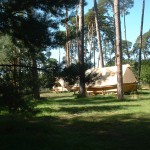 They say that the three most stressful events in your life are moving house, getting divorced and loss of a loved one. But they forgot one thing. Going camping. Sometimes it feels like it’s up there with the big three. I might as well be moving house with all the stuff I need to take. This alone is enough to put our marriage in the balance, never mind the potential to throttle one of my loved ones in the process. It takes me about two days to recover after finally getting the tent up.
They say that the three most stressful events in your life are moving house, getting divorced and loss of a loved one. But they forgot one thing. Going camping. Sometimes it feels like it’s up there with the big three. I might as well be moving house with all the stuff I need to take. This alone is enough to put our marriage in the balance, never mind the potential to throttle one of my loved ones in the process. It takes me about two days to recover after finally getting the tent up.
But last year, we did it, loved it, and survived to tell the tale. All thanks to the genius behind Huttopia, an innovative eco-friendly campsite in Rambouillet, in the Yvelines region of northern France. We had already stayed in a wooden lodge at their Versailles site on a visit to Paris, where our neighbouring cream canvas tents made camping look almost romantic again.
Huttopia has worked out how to do camping sans stress, providing everything from bedding to bottle openers. Packing, what packing? Clothes, books, games and a few sandwiches for the journey. That was it. We even had room for kids’ bikes in the boot. So no bike carrier nonsense to up the stress levels at 6am on the morning of departure either. The ferry crossing was smooth, and the autoroutes traditionally traffic-free as we were staying north, rather than joining the rabble heading south on the Route du Soleil.
But this was just the calm before the storm. The rain started about five kilometres outside Paris, and didn’t stop for five days. We arrived at a mud-filled campsite, our craved cream canvas still looking remarkably cream, however, in that way that probably only the French can do. It had been raining for days apparently, to the point where some people had packed up and gone home. Or joined the Route du Soleil.
Impossible though it may seem, the tent’s interior put smiles back on our faces very quickly. Because this is camping, Jean, but not as you know it. Despite the noise of humungous droplets of rain falling off the pine trees onto our canvas, providing a symphonia of drumming noises, everything was dry as a bone. Rain and camping were not a novelty to us, but dryness was. 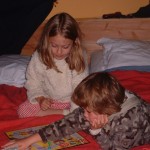
These tents are huge, and joy of joys for my six feet plus husband, he could stand up. This sounds trite, but for those who have spent two weeks crouching under canvas, this changes everything. There are two bed sections, side by side, each concealed behind a thick dark green canvas curtain. You can remove the divide between sections if you are comfier having one big family sleeping area, but our boys were ecstatic to have their own room.. And mattresses. Proper mattresses, made of firm foam. Not air, not army, not yoga. The real thing, squidgy, warm and lifted off the ground on a raised wooden platform. Just to add to the five star-ness of it all, there are crisp laundered white sheets, pillowcases (on pillows, not a bundle of clothes under my neck), and beautiful big thick fleecy blankets to make our cocoons exquisitely cosy.
There are many little coups of brilliance in these exquisitely designed tents, which are called ‘Canadiennes’, because they are modelled on a Canadian design. The ‘bedrooms’ have solar powered lights which, despite the weather, provided plenty of light for reading and a nightlight for little ones. An expresso maker, the ones you twist and burn your hands on, as opposed to a machine (this is camping after all), a proper wooden dining table (one inside and out, so you don’t need to keep moving it), a fridge, a metal trunk to store all your clothes in, and sweeping brushes for the dried mud. Everything but the kitchen sink, of course. Unlike many campsites, washing your dishes, or yourselves, is an extremely enjoyable ritual at Huttopia, with stylish wooden wash lodges, ceramic (not grotty stainless steel) sinks, and proper showers, all decorated in tasteful forest green shades, straight out of a Farrow and Ball catalogue.
The rain did stop of course, just in time for us to have read all our books, and finish a few mammoth sessions of Monopoly. All tucked up on sofas in the cosy games room of the site’s wooden chalet, with wood-burning pizza oven constantly on the go, and kids bonding around the ‘babyfoot’, parents around the beer.
The Huttopia sites are carefully thought out. This one sits on the banks of a lake, which we cycled around daily, as it is only a few kilometres so fine for little legs (and the kids found it easy too). It is surrounded by the RambouilletForest, a vast expanse of oak and pine, with an excellent layout of cycling and hiking trails. Within 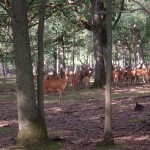 minutes’ walk of our tent, we had access to 200 000 hectares of forest with its richly biodiverse flora and fauna. Of the latter, deer and wild boar are most common, although they stayed well clear of all the happy little campers. A twenty minute easy cycle through woodland takes you to the town of Rambouillet. It is idyllically French, with plenty of boucheries and boulangeries to stock up on daily supplies. Spend a morning strolling round the chateau, lunch at the creperie, and then sip a glass of wine at the town square bar, watching the kids go round on the antique carousel, and you have to blink to remind yourself you aren’t in an arthouse movie.
minutes’ walk of our tent, we had access to 200 000 hectares of forest with its richly biodiverse flora and fauna. Of the latter, deer and wild boar are most common, although they stayed well clear of all the happy little campers. A twenty minute easy cycle through woodland takes you to the town of Rambouillet. It is idyllically French, with plenty of boucheries and boulangeries to stock up on daily supplies. Spend a morning strolling round the chateau, lunch at the creperie, and then sip a glass of wine at the town square bar, watching the kids go round on the antique carousel, and you have to blink to remind yourself you aren’t in an arthouse movie.
Huttopia is the beautiful baby of one couple, Philippe and Celine Bossanne, whose ever-growing family has spread to five different sites in different corners of France. They make every effort to respect their natural heritage, and have excellent eco-friendly practices in place. One of the most impressive is the natural swimming pool, which is filtered by sand and reedbeds. Not a hint of chemicals, and no stingy eyes at the end of the day.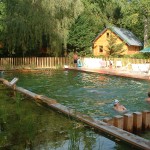 Getting past French bureaucracy to build this was a battle for the Bossannes, but they fought for what they believed in, and have now managed to change the law, making it easier for others to build eco-pools in future. Consequently, only this site and their new one in Senonches, have these pools to date. Another refreshing feature is that their sites are car-free, so the children were never off their bikes.
Getting past French bureaucracy to build this was a battle for the Bossannes, but they fought for what they believed in, and have now managed to change the law, making it easier for others to build eco-pools in future. Consequently, only this site and their new one in Senonches, have these pools to date. Another refreshing feature is that their sites are car-free, so the children were never off their bikes.
They invite their guests to follow the green path too, but not though lecturing and endless notices to recycle this or switch off that. The shop is full of local produce, and there are daily activities which take you out into the landscape. We signed up for the twilight nature trek through the forest. This was led by the manager of the nearby Espace Rambouillet, an enclosed section of the forest set up to educate and conserver this precious resource. He put us into two teams and, hoping that we had enough French between us, we headed off on a treasure hunt, finding clues concealed under leaves or in tree trunk hollows and filling in nature quiz questions as we went. We ended up walking for hours, making new friends en route and the kids racing the whole way round to see if they could be the winning team back to base. I couldn’t imagine that much enthusiasm if I had suggested a three hour walk in the woods to study nature, somehow.
Funnily enough, our teammates on this nature trek have since become close friends and we are all going back to Huttopia again together this summer. Just to add to the Enid Blyton-ness of it all, we are not even taking the car this time. Ferry, then train to Paris, a forty minute train ride to Rambouillet, and a stroll through the woods to our favourite pitch by the lake. We will hire bikes when we are there, and chill out for two whole weeks. Rain or shine, we are hooked on Huttopia, and camping converts for life.
Staying at Huttopia
Stay at Huttopia’s Rambouillet site in the Yvelines region, or at one of their other sites at Senonches, Font-Romeu, Rille or Versailles. At Rambouillet, you can take your own tent ( from €17.40 per night), rent a ready-to go ‘Canadienne’ tent (from €55 per night) or go for the more solid options of a wooden ‘Cabane’ (from €120 per night), or a wooden ‘Roulotte’ or caravan (from €85 per night). To book, see www.huttopia.com, and for the Rambouillet site tel: 00 33 1 30 41 07 34. For other sites, see website for details.
Go there
Overnight ferry from Rosslare to Le Havre, see www.ldlines.ie, from €79 one way for car and two passengers. Drive 200kms from Le Havre to Rambouillet or if you want to leave the car at home, catch a train from Le Havre to Paris (2.5 hours), change stations and then another 30 minutes to Rambouillet. Book this through Irish Rail’s European Reservations Tel: 01 703 1885 or email europeanrail@irishrail.ie. Or fly to Paris and take a train.
Where to eat and go if you’re in Rambouillet
Le Pradaud bar has a terrace overlooking Rambouillet’s town square and chateau. Unglamorous, so perfect for muddy camper, and right beside the town carousel.
Le Savoyard, 46, rue d’Angiviller, Tél. 01 34 83 35 77 brings a little bit of the Alpine tradition to the Yvelines region, with excellent fondue, raclette and superb regional wines to accompany the ideal outdoorsy meal, after a day of hiking and biking.
Visit L’Espace Rambouillet, a great family day out in this vast expanse of Rambouillet’s forest park, where you can see wild deer and boar, and dramatic falconry displays (From experience, hide your sandwiches during this). See the forest at its finest from its ‘Odyssee Verte’ suspended walkway through the trees. See www.onf.fr/espaceramb. Just a ten minute cycle from the campsite.
(This article was first published in The Irish Times, 18 April 2009)
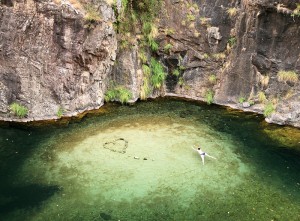
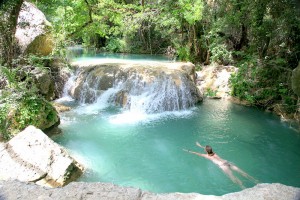
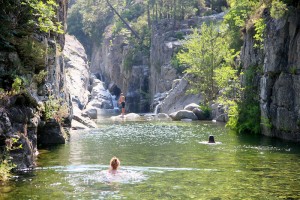

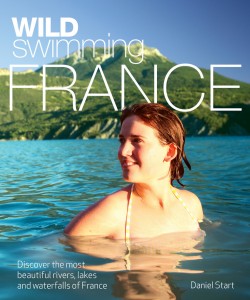
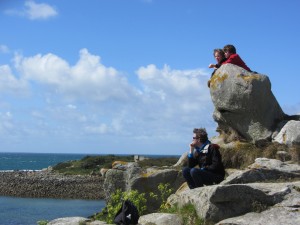
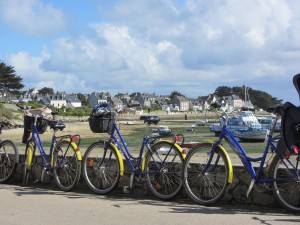
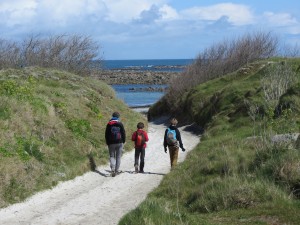
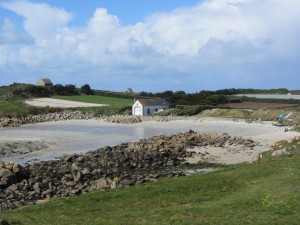
 They say that the three most stressful events in your life are moving house, getting divorced and loss of a loved one. But they forgot one thing. Going camping. Sometimes it feels like it’s up there with the big three.
They say that the three most stressful events in your life are moving house, getting divorced and loss of a loved one. But they forgot one thing. Going camping. Sometimes it feels like it’s up there with the big three. 
 minutes’ walk of our tent, we had access to 200 000 hectares of forest with its richly biodiverse flora and fauna. Of the latter, deer and wild boar are most common, although they stayed well clear of all the happy little campers. A twenty minute easy cycle through woodland takes you to the town of
minutes’ walk of our tent, we had access to 200 000 hectares of forest with its richly biodiverse flora and fauna. Of the latter, deer and wild boar are most common, although they stayed well clear of all the happy little campers. A twenty minute easy cycle through woodland takes you to the town of  Getting past French bureaucracy to build this was a battle for the Bossannes, but they fought for what they believed in, and have now managed to change the law, making it easier for others to build eco-pools in future. Consequently, only this site and their new one in Senonches, have these pools to date. Another refreshing feature is that their sites are car-free, so the children were never off their bikes.
Getting past French bureaucracy to build this was a battle for the Bossannes, but they fought for what they believed in, and have now managed to change the law, making it easier for others to build eco-pools in future. Consequently, only this site and their new one in Senonches, have these pools to date. Another refreshing feature is that their sites are car-free, so the children were never off their bikes.